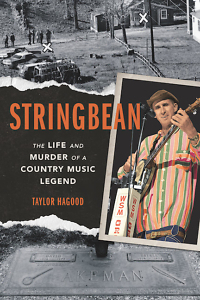Avant-Garde Traditionalist
Taylor Hagood uncovers the life and death of country music icon David “Stringbean” Akeman
Singer, comedian, and banjo player David Akeman, better known as Stringbean, made his mark as a bluegrass pioneer and star of the television show Hee Haw, and he wielded an instrument that evoked modern ambiguities and old-time practices. Taylor Hagood’s Stringbean: The Life and Murder of a Country Music Legend lays out Akeman’s life story and details the murder of Akeman and his wife, Estelle, at their house near Nashville on November 10, 1973. The murders and the subsequent trials marked a turning point in the history of country music.

Akeman was born in Jackson County, Kentucky, in 1915, and he grew up listening to the Grand Ole Opry, the Nashville radio program that featured country musicians like Uncle Dave Macon, who would become Akeman’s biggest influence. He began playing banjo at 14 and weathered the Great Depression by working at a Civilian Conservation Corps site, where he helped build roads and lookout towers. A notably tall, skinny young man, Akeman got his stage moniker in 1935, when a fellow musician, Asa Martin, called him “String Bean” or “String Beans” during a radio performance on WLAP in Lexington, and the name stuck.
It’s clear Hagood set out to give Akeman the credit he deserves as a traditional musician who also made major contributions to the avant-garde of stringed instrument playing that includes blues guitarist Skip James, banjo player Dock Boggs, and all manner of 20th-century folk and rock musicians. Hagood writes lyrically about Akeman’s relationship with the instrument:
Already instrument and man may have been entwining as two living beings, not necessarily a specific banjo but “banjo” and the entity growing within David, an avatar that as yet had no name but was sprouting inside him and bound up with the entity of banjo-ness.
By 1942 Akeman had secured a job with the inventor of bluegrass music, Bill Monroe. Akeman was, in fact, the first banjo player in Monroe’s Blue Grass Boys, and he played in the two-finger clawhammer style. It was during this period that he began to step fully into the comic persona of “Stringbean,” adopting the trademark costume that exaggerated his already long torso. Hagood describes it from a 1950s performance:
He wears a long-sleeved orange gingham shirt that stretches well below his waist and is sewn onto short blue jeans with a leather belt in place unnecessarily. A keychain loops over the right hip pocket, while a white handkerchief sticks out of his back left pocket. His tiny black coachman hat looks too small for his head.
Akeman’s abilities as an entertainer made him a natural for the Opry, where he was a fixture from 1944 until his death, though he briefly left the show to travel with a musician named Tommy Scott. One of the pleasures of reading Hagood is being able to luxuriate in the raffish world of country music as it existed in the ‘40s and ‘50s. With Scott, Hagood tells us, Stringbean had a chance to tour with his Hillbilly Jamboree and Circus Review, which hawked a patent medicine called Herb-O-Lac.
 By the early ‘60s, young folk enthusiasts viewed Akeman as a bluegrass musician. When he appeared at the 1965 University of Chicago Folk Festival, the bookers forbade him from wearing the costume. For the folkies of the ‘60s, this was strictly about music, and as such was deadly serious.
By the early ‘60s, young folk enthusiasts viewed Akeman as a bluegrass musician. When he appeared at the 1965 University of Chicago Folk Festival, the bookers forbade him from wearing the costume. For the folkies of the ‘60s, this was strictly about music, and as such was deadly serious.
Because Akeman often used a banjo tuning that allowed him to use the Lydian mode, with the relationship between the third and fourth notes in the mode a whole step, he extended the tonality of the banjo. (Since he preferred the key of A, this means the fourth note in the mode is a D-sharp.) Hagood describes a 1961 performance of the folk tune “Pretty Polly” that Akeman delivered on The Porter Wagoner Show that sounds like it uses this tuning. It’s both futuristic and old-time and a remarkable snapshot of ‘60s folk.
By the time of the murders, Akeman had made a small fortune in the music business. The Akemans were reputed to distrust banks and carry around a lot of cash, and this seems to have been why a pair of cousins, Doug Brown and John Brown Jr., decided to target them. While waiting for the couple to return home, the killers tuned in the radio to listen to Stringbean play his final show on the Opry.
Hagood delves into the labyrinth of the 1974 trials, and it’s the sheer futility of it all — the Akemans were beloved by everyone — that gets to you when you finish. The Browns never found the nearly $6,000 that David and Estelle Akeman had on them when they died, and to this day, no one has found Stringbean’s will or the murder weapon. His banjo — a beautiful Vega No. 9 five-string — is in the possession of Nashville’s Country Music Hall of Fame and Museum.

Edd Hurt is a writer and musician in Nashville. He’s written about music for Nashville Scene, American Songwriter, No Depression, The Village Voice, and other publications. He produced and played keyboards on The Contact Group’s 2021 album of 1970s covers, Varnished Suffrages.


